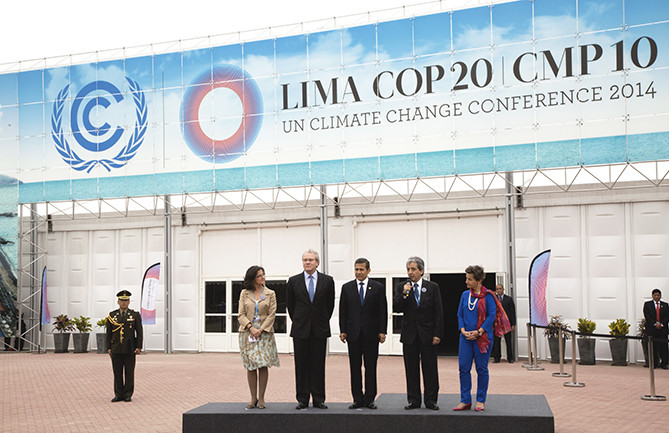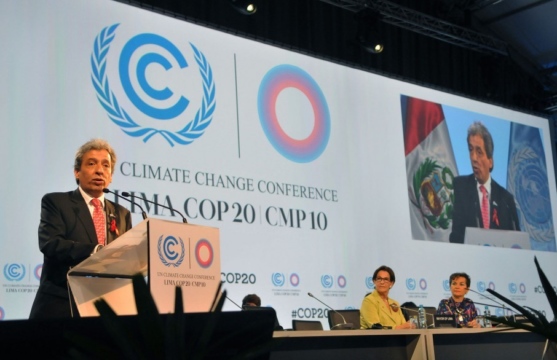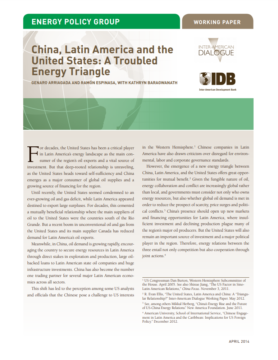
Navigating Risk in Brazil’s Energy Sector
Brazil’s oil and gas and electricity sectors are an important destination for Chinese direct investment.
Q: The United Nations Climate Change Conference, COP20, will be held this December in Lima, Peru. The meeting is intended to promote dialogue among member countries and produce a draft text for a climate deal on reducing greenhouse gas emissions for the meeting in Paris next year. What are the opportunities for progress and regional cooperation on climate change in the Americas? What do you expect to happen at the conference, and what does it mean for the region's energy sector moving forward?
A: Timmons Roberts, professor of sociology and environmental studies and co-director of the Climate and Development Lab at Brown University: "The Conference of the Parties in Lima is a crucial opportunity for both the global set of 195 nations and for those in Latin America to come up with draft language for the deal, which is due to be finalized next December in Paris. Some Latin American nations have been true leaders on climate change, in two ways. First, some of the most efficient nations in the world are in the region, creating societies with high levels of social development (life expectancy, health, literacy, etc.) and which emit quite low levels of carbon and other greenhouse gases. Some innovative low-carbon solutions have been developed in the region, which are diffusing around the world. Second, Latin America is an emerging leader in the U.N. negotiations, since Mexico rescued the process in 2010 with its brilliant hosting of the Cancún talks. A new negotiating group, the Alliance of Independent Latin American States (AILAC, consisting of six nations) has begun advancing a position that all countries need to make efforts to reduce their emissions, and that doing so can bring immediate and longer-term economic and social benefits. The region has a strong and growing portfolio of renewable energy (hydroelectric, sugar cane ethanol, some wind and solar), but a few nations are heavily dependent upon the production and export of fossil fuels. There are some divisions in negotiating groups from the region, but there is great opportunity for cohesion around preventing dangerous climate change and moving to a just and green energy future. Latin America can lead the world toward low carbon futures, but intensive efforts are needed, supported by international financial assistance, technology and strategy exchange."
A: Lisa Viscidi, member of the Energy Advisor board and director of the Energy, Climate Change and Extractive Industries Program at the Inter-American Dialogue: "Latin America represents a relatively low but rising percentage of global carbon emissions, and climate change mitigation in the energy sector is an increasingly important issue. The region has a 12 percent share of global GDP, but produces only 6 percent of global greenhouse gas emissions, thanks largely to the widespread use of clean energy produced by hydroelectric plants. However, Latin America's share of global emissions is projected to rise due to the growth of the transport and manufacturing sectors. The World Bank found in 2011 that without regional cooperation and adoption of climate change policies, CO2 emissions from energy consumption would increase by about 33 percent per capita (compared to the global average of 24 percent) by 2030. Several countries are taking steps to cut climate emissions, and these measures may have an important impact on the energy sector. Since 2009, several Latin American countries have adopted Nationally Appropriate Mitigation Actions (NAMAs) to address their specific role in mitigating the effects of climate change, many of which target the energy sector by improving energy efficiency and expanding renewable energy sources. In addition, Chile recently introduced a carbon tax in an effort to reduce emissions from the energy sector. Mexico has also established a carbon tax and is developing a voluntary emissions trading scheme to help reach its goal of generating 35 percent of electricity from renewable sources by 2018. As the COP20 host country, Peru will look to showcase its national plan of environmental action for 2010–2021, which aims to increase electricity generation from renewable energy sources and improve energy efficiency in order to reduce emissions by 28 percent compared with 2000 levels."
A: Milena Gonzalez, research associate in the Climate & Energy Program at the Worldwatch Institute: "There are numerous opportunities for progress and regional cooperation on climate change in the Americas. It is a region privileged with diverse and abundant natural resources that is also particularly vulnerable to impacts of climate change, which will have profound effects across the region's economy, ecosystems and biodiversity. While the level of climate change adaptation in the region remains low, multiple studies have shown that investments in adaptation strategies would result in large economic benefits, suggesting the need to prioritize them at national and regional levels. The highest sources of greenhouse gases in the region continue to be land-use change, deforestation and unsustainable agriculture. These challenges have yielded significant regional cooperation, but space for progress remains. With regard to energy, declining costs, proven technologies and vast untapped potentials offer an unprecedented opportunity to further develop renewable energy and increase energy efficiency in the region, simultaneously addressing climate change mitigation and other development challenges—such as achieving universal access to modern energy services, meeting future energy demand and increasing energy security—while minimizing affects on the environment and increasing the resiliency of energy systems. This development will continue to create opportunities for regional cooperation on finance, capacity building, standardization of components, and trade of renewable energy products and electricity. The COP20 has the opportunity to become a milestone in the history of climate change in the region, as a litmus test for COP21 in Paris. Peru, like some other countries in the Americas, has been proactive in terms of climate change action and in its leadership role with respect to COP20, but it will need the support and active participation of the rest of the region to raise the ambition and create a strong foundation for a new climate deal that considers the region's current situation and needs."
A: Ramiro Fernández, climate change director for Latin America at the Avina Foundation: "Beyond ideological differences, Latin America shares a number of elements that could strengthen its global leadership to meet the challenges of climate change, generating a development model that is low in emissions and climate-resilient. This would be based on a strategy that values ecosystems and biodiversity, thus reducing emissions from deforestation. At the same time, while the region generally has low emissions from the energy sector, diversifying its energy matrix, incorporating renewable energies and promoting energy efficiency will offer the region economic, energy security and environmental benefits. Finally, as developing countries, the region suffers the effects of climate change with limited capacities to adapt, an integrated adaption strategy based on the services of their ecosystems would be of high impact for the region. The COP20 should provide results in terms of climate financing with the capitalization of the Green Climate Fund, generate advances in mitigation commitments prior to 2020 and present a first-draft text that will allow the negotiation to advance toward a binding climate agreement in 2015, which would begin to be implemented in 2020. All of these can and should generate incentives to increase the role of renewable energies and energy efficiency in Latin America as part of its strategy of climate-resilient and low-carbon development."
A: Ana R. Ríos, climate change specialist at the Inter-American Development Bank: "The United Nations Climate Change Conference is seen as a stepping stone for the meeting in Paris next year. Voluntary pledges on the reduction of greenhouse gases (GHG) that will serve as a basis for the legally binding universal agreement targeted for 2015 are expected to be achieved. COP20 comes at a crucial time when evidence indicates that urgent measures are needed to avoid surpassing the 2°C guardrail. We are simply running out of time, and commitments that translate into action are needed worldwide in both climate change mitigation and adaptation fronts. Latin America and the Caribbean (LAC) has the opportunity to contribute to this challenge. The region's share of global GHG emissions is relatively low, but is projected to increase given current consumption patterns and population growth. Moreover, climate change could affect its comparatively clean energy basis (hydropower generation nowadays accounts for over 20 percent of the energy matrix). Additionally, LAC's vulnerability to climate change is significant and poses an additional challenge to the achievement of sustainable development. These key characteristics highlight the prospect for progress and cooperation in terms of adaptation-driven mitigation actions particularly in land use, agriculture and energy—areas where considerable emission reductions could be achieved while tackling climate change vulnerability. Moving forward, this could lead to a reinforcement of efforts oriented toward the sustainable management of forests, recuperation of degraded lands, optimal use of agricultural inputs, energy efficiency measures and deployment of non-traditional renewable energy sources."
Brazil’s oil and gas and electricity sectors are an important destination for Chinese direct investment.
In December, world leaders will travel to Lima, Peru to participate in United Nations COP 20 talks.
The US’ standing as the main consumer of Latin America’s oil exports is unraveling as China emerges as a major consumer of global oil supplies.
 United Nations
United Nations

